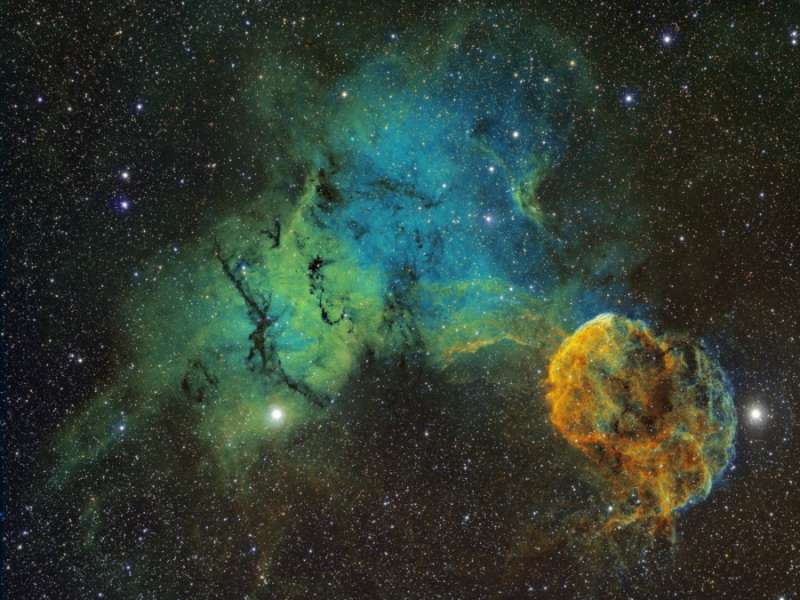Credit & Copyright: Bob Franke
Explanation:
Normally faint and elusive, the Jellyfish Nebula is caught in
this
alluring, false-color, telescopic view.
Flanked by two bright stars,
Mu
and
Eta
Geminorum,
at the foot of a
celestial
twin,
the Jellyfish Nebula is the brighter arcing
ridge of emission with dangling tentacles below and right of center.
In fact, the cosmic jellyfish is seen to be part of bubble-shaped
supernova remnant IC 443, the expanding
debris cloud from a
massive
star that exploded.
Light from the explosion first reached planet Earth over 30,000 years
ago.
Like its cousin in astrophysical waters the
Crab Nebula
supernova remnant, IC 443 is known to harbor
a neutron star, the remnant of the collapsed stellar core.
Emission nebula Sharpless 249 fills the field at the upper left.
The Jellyfish Nebula is about 5,000 light-years away.
At that distance, this image would be about 300 light-years
across.
The color scheme used in the narrowband composite was
made popular in Hubble Space Telescope images,
mapping emission
from oxygen, hydrogen, and sulfur atoms to blue,
green and red colors.
1999 2000 2001 2002 2003 2004 2005 2006 2007 2008 2009 2010 2011 2012 2013 2014 2015 2016 2017 2018 2019 2020 2021 2022 2023 2024 2025 |
Yanvar' Fevral' Mart Aprel' Mai Iyun' Iyul' Avgust Sentyabr' Oktyabr' Noyabr' Dekabr' |
NASA Web Site Statements, Warnings, and Disclaimers
NASA Official: Jay Norris. Specific rights apply.
A service of: LHEA at NASA / GSFC
& Michigan Tech. U.
|
Publikacii s klyuchevymi slovami:
supernova remnant - emission nebula - emissionnaya tumannost' - ostatok Sverhnovoi - vzryvy sverhnovyh - uzkopolosnyi fil'tr
Publikacii so slovami: supernova remnant - emission nebula - emissionnaya tumannost' - ostatok Sverhnovoi - vzryvy sverhnovyh - uzkopolosnyi fil'tr | |
Sm. takzhe:
Vse publikacii na tu zhe temu >> | |
